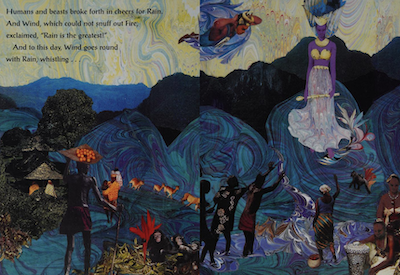The book contains 107 stories, organized into different sections as follows (these are links to the specific story pages at Internet Archive):
PART I. Getting Things Started: How the World Got Put Together That Way
Never Seen His Equal / The Man Makes and the Woman Takes / Bringing Men and Women Together / The Fight over Life / The Wind and the Water Fighting / The Word the Devil Made Up / The Knee-High Man Tries to Get Sizable / Pig’s Long Nose and Greedy Mouth / Getting Common Sense / Hankering for a Long Tail / The Devil’s Doing / The John Crows Lose Their Hair / Tadpole Loses His Tail / The Owl Never Sleeps at Night / Why Hens Are Afraid of Owls / The Gifts of Dipper and Cowhide / Buh Nansi Scares Buh Lion / Testing the Good Lord / MrPossum Loves Peace / Get Back, Get Back / No Justice on Earth
PART II. Minding Somebody Else’s Business and Sometimes Making It Your Own
Meeting the King of the World / MrBamancoo Gets Dropped / The Tug-of-War between Elephant and Whale / Tiger Becomes a Biding Horse / The Telltale Pepper Bush / Making the Stone Smoke / The Latest Song / The Signifying Monkey / The Singing Bones / A Boarhog for a Husband / The Woman Who Was a Bird / My Mother Killed Me, My Father Ate Me
PART III. Getting a Comeuppance: How (and How Not) to Act Stories
What Makes Brer Wasp Have a Short Patience / Between the Fiddler and the Dancer / Being Greedy Chokes Anansi / The Doings and Undoings of the Dogoshes / Spreading Fingers for Friendship / Don’t Shoot Me, Dyer, Don’t Shoot Me / Little Eight John / The Poor Man and the Snake / The Little Bird Grows / Tricking All the Kings / The Feast on the Mountain and the Feast under the Water / Hide Anger until Tomorrow / Buying Two Empty Hands / Cutta Cord-La / Brer Bear’s Grapevine / A Foolish Mother / Old Granny Grinny Granny / You Never Know What Trouble Is until It Finds You / He Pays for the Provisions / The Cunning Cockroach / Little Boy-Bear Nurses the Alligator Children / The Girl Made of Butter / Poppa Stole the Deacon’s Bull / The Trouble with Helping Out / The Rooster Goes Away in a Huff
PART IV. How Clever Can You Get? Tales of Trickery and Its Consequences
Why They Name the Stories for Anansi / Brother Rabbit Takes a Walk / The Lion in the Well / A License to Steal / The Race between Toad and Donkey / Crawling into the Elephant’s Belly / A Strange Way to Sleep / Goobers Gone, Rabbit Gone / Assaulting All the Senses / Brer Rabbit’s Riddle / The Horned Animals’ Party / Anansi Plays Dead / Anansi Climbs the Wall / Dancing to the River / “Trouble” Coming Down the Road / No Chicken Tonight
PART V. The Strong Ones and the Clever: Contests and Confrontations
Golden Breasts, Diamond Navel, Chain of Gold / The Flying Contest / Loggerhead / Trying to Get the Goldstone / Stackolee / Escaping, Slowly / Turning into Nóuna—Nothing / The Old Bull and the Young One / Fasting for the Hand of the Queen’s Daughter / Weak in the Day and Strong at Night / Jack Beats the Devil / Three Killed Florrie, Florrie Killed Ten
PART VI. Getting Around Old Master (Most of the Time)
They Both Had Dead Horses / You Talk Too Much, Anyhow / Making the Eyes Run / Making a Wagon from a Wheelbarrow / The One-Legged Turkey / John Outruns the Lord / A Flying Fool / Horses Stay Outside / The Sinking of the Titanic / Competition for Laziness / John Outwits MrBerkeley / Black Jack and White Jack / Philanewyork / The Barn Is Burning
PART VII. In the End, Nonsense
There are notes on all the stories in the back, plus informative introductions to each section, along with a comprehensive bibliography. It's a perfect jumping-off point to learn more about both African American and Caribbean storytelling traditions.
Abrahams is also the author of other important books on African American culture, especially language and storytelling. You can find out more about his long career as a scholar here at Wikipedia. Abrahams died just a few years ago, in 2017; here is his obituary in the New York Times.
Here are just a few of his other books that you can find at Internet Archive:
Meanwhile, if you want a comprehensive overview, just spend some time with Abrahams's African Folktales and African American Folktales, both of which are ready and waiting at the Archive.













































